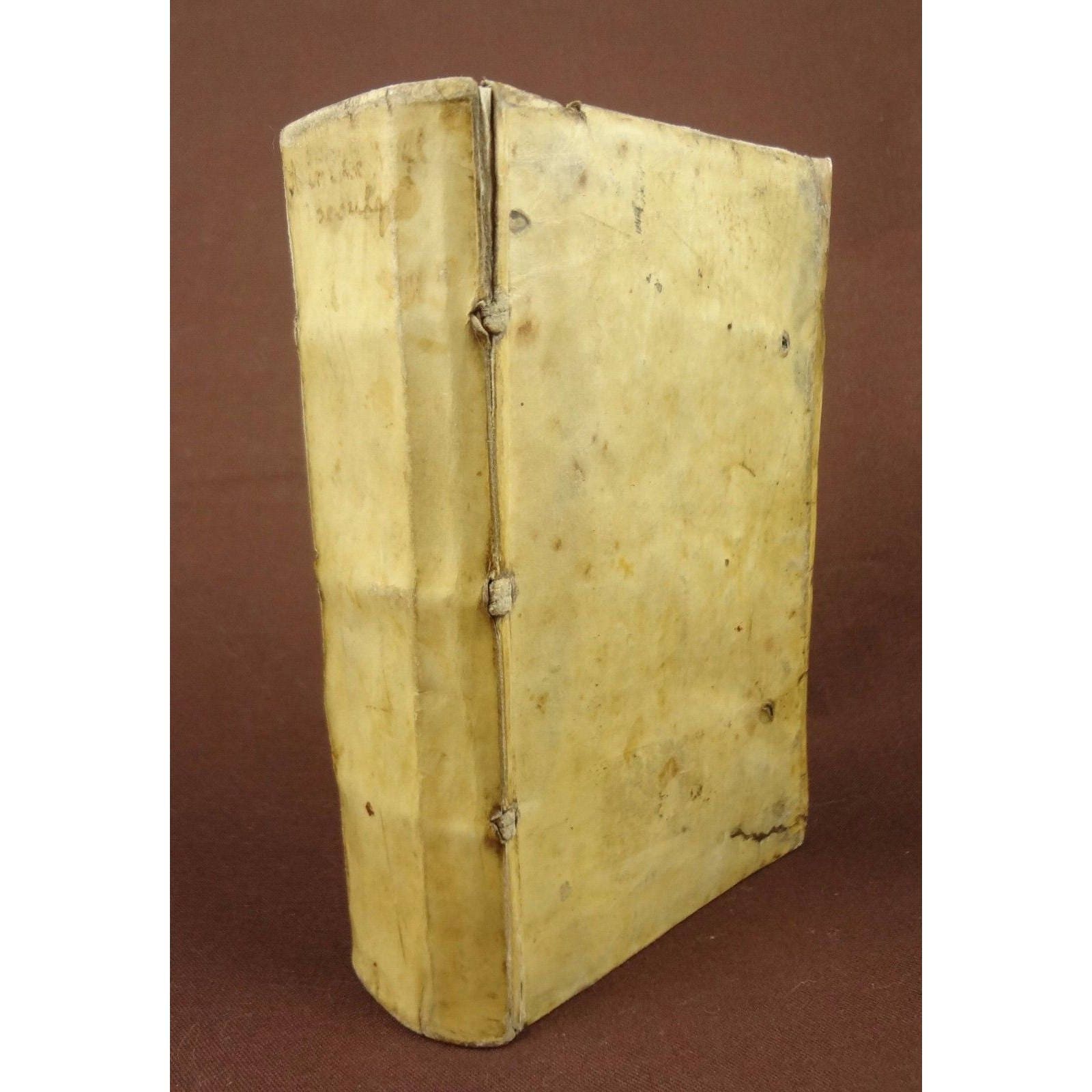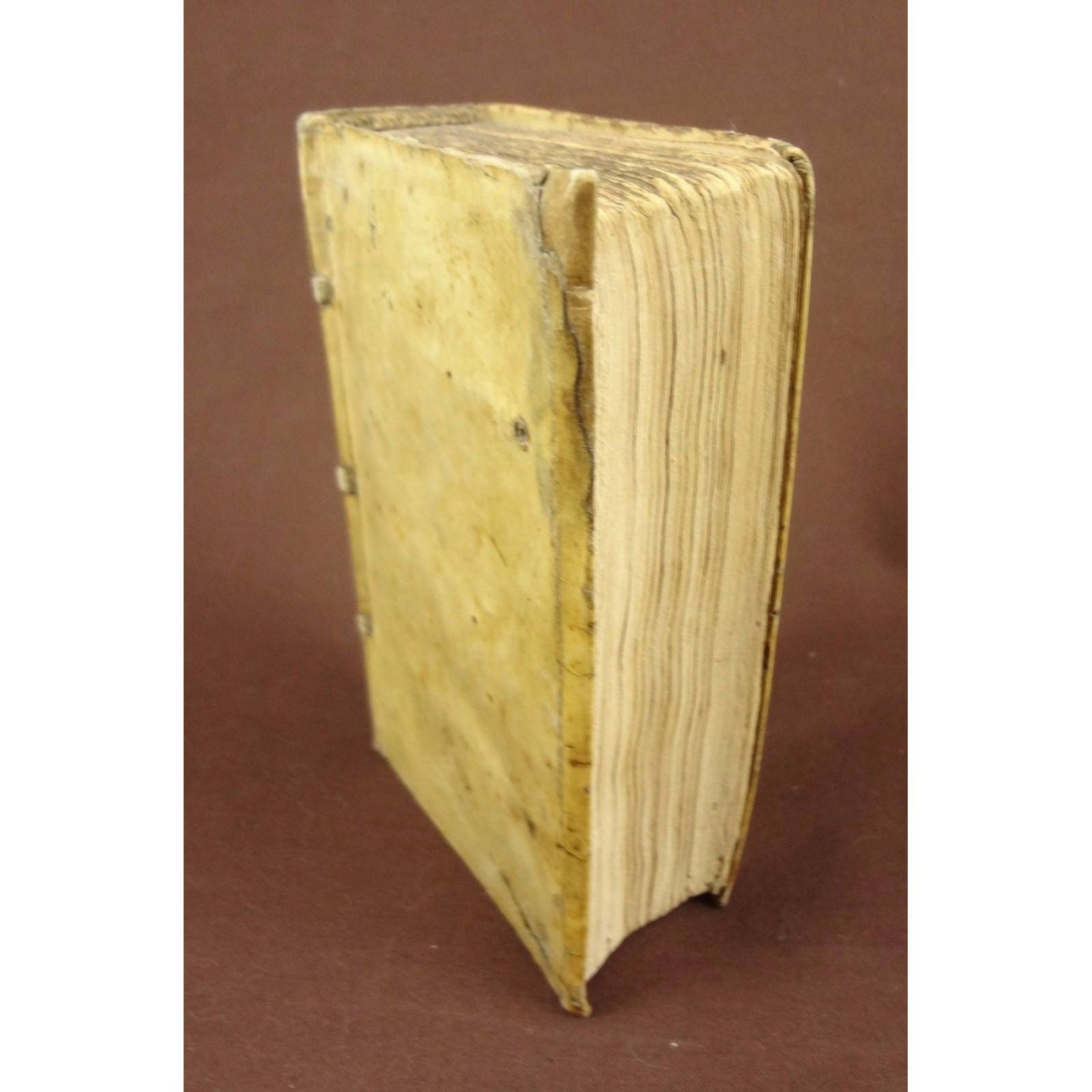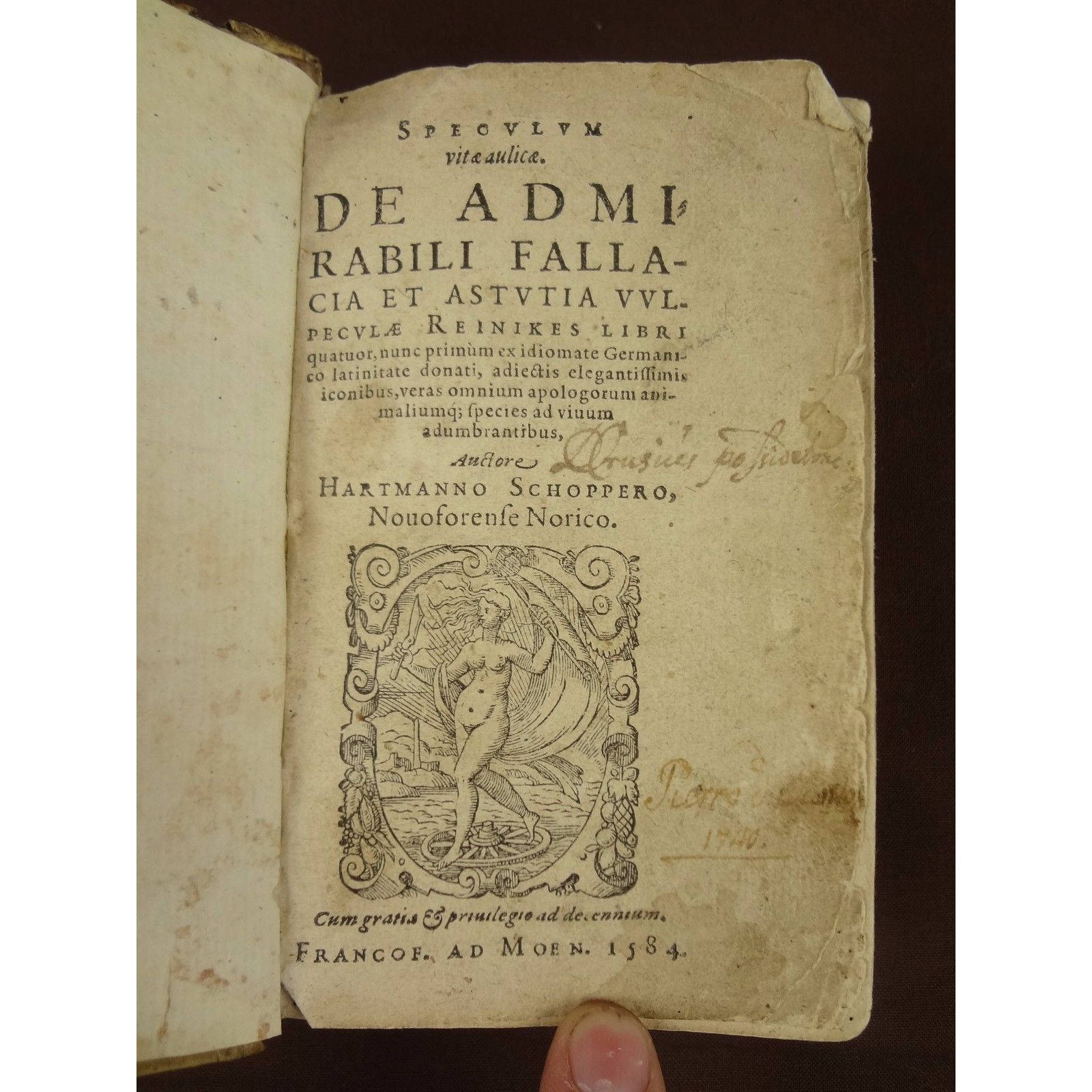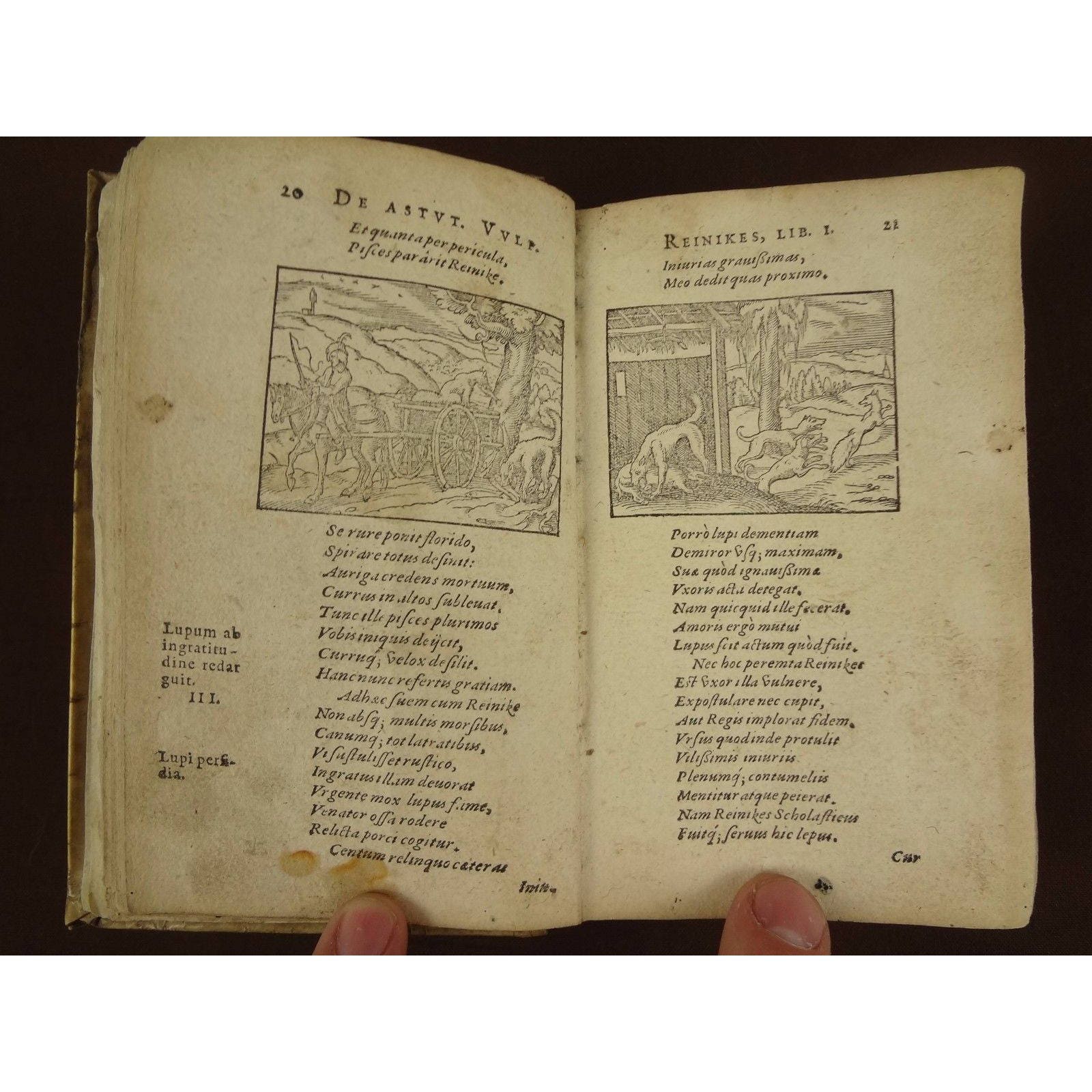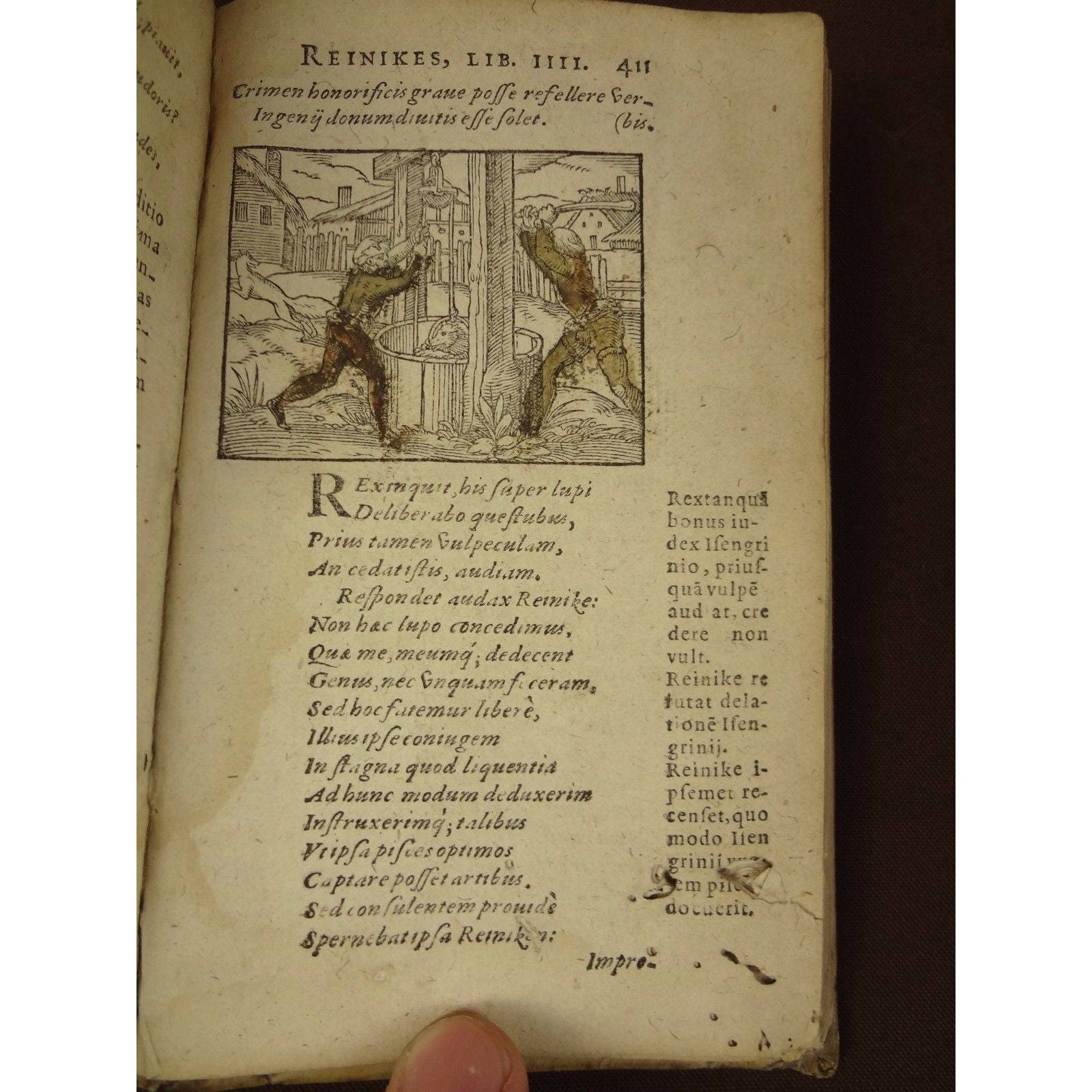The first Latin translation of Reynard the Fox by Hartmann Schopper (5th edition), illustrated with 57 woodcuts (51 blocks) by the venerable Jost Ammon & Virgil Solis, and printed at the legendary Frankfurt at Main by the rogue printer Basse. A wonderful example of medieval and renaissance moral literature, delightfully illustrated, likely used for the education of children (as evidenced by the nine woodcuts that have some minor contemporary coloring).
Schopper’s Reynard
"Schopper was born at Neumarkt, in the Upper Palatinate, in the year 1542 ; he appears to have devoted himself to study, and, in 1565, commenced a translation of Reinike into Latin verse, at the suggestion of Sigismund Feyerabend, the bookseller of Frankfort. His task was interrupted by his being compelled to enter the army, and then cast into prison at Freiburg. From Freiburg he appears to have ascended the Danube to Vienna, having first assigned to another the task of finishing his translation."
"His military career would seem to have terminated at Vienna, where he was attacked by a violent fever, and fell into such distress, that he had not a bed to rest on, but slept in the streets, and found shelter in an empty cask. At length, Josias Hufnagel, whom Schopper had not previously known, took pity upon him, out of regard to his talents and reputation, assisted him, gave him a sword and cloak (in lieu of those which had been stolen from him), and procured him the medical assistance of Paul Fabritius, the imperial physician. Having somewhat recovered, he returned in the autumn to Frank fort, where he was most kindly received by M. Johann Cuipius, the son-in-law of Christopher Egenolph, upon whose encouragement he completed his translation, and dedicated it to the Emperor Maximilian II, to whom he complains bitterly of the poverty and hardships which he had endured."
"This translation, which has contributed so greatly to spread Reynard's fame among scholars who were unable to read his history in any of the Teutonic versions, was published at Frankfort, in 1567. There are no less than five other editions of this work published in the years 1574, 1579, 1580, 1584, and 1595 respectively, all bearing the title of Speculum Vitae Aulicae. De Admirabili Fallacia, and illustrated by the same admirable woodcuts by Virgilius Solis, and Jost Ammon. The reader may be curious to see a specimen of a work, of which the literary history is certainly somewhat remarkable, and of which the merit appeared to Lotichius so great as to justify him in comparing the author with Ovid and Tibullus." - William J Thoms, History of Reynard the Fox, 1844
The Complete Work
Google has scanned an entire copy of this edition which you can review at:
https://books.google.com/books?id=j3GsnH5mWqUC&num=13
History of Reynard the Fox
"Reynard (German: Reineke) is the main character in a literary cycle of allegorical Dutch, English, French and German fables. Those stories are largely concerned with Reynard, an anthropomorphic red fox and trickster figure. His adventures usually involve him deceiving other anthropomorphic animals for his own advantage or trying to avoid retaliations from them. His main enemy and victim across the cycle is his uncle, the wolf Isengrim (or Ysengrim). While the character of Reynard appears in later works, the core stories were written during the Middle Ages by multiple authors and are often seen as parodies of medieval literature such as courtly love stories and chansons de geste, as well as a satire of political and religious institutions."
"The figure of Reynard is thought to have originated in Lorraine folklore from where it spread to France, the Low Countries, and Germany. An extensive treatment of the character is the Old French Le Roman de Renart written by Pierre de Saint-Cloud around 1170, which sets the typical setting. Reynard has been summoned to the court of king Noble, or Leo, the lion, to answer charges brought against him by Isengrim the wolf. Other anthropomorphic animals, including Bruin the bear, Baldwin the ass, and Tibert (Tybalt) the cat, all attempt one stratagem or another. The stories typically involve satire whose usual butts are the aristocracy and the clergy, making Reynard a peasant-hero character. The story of the preaching fox found in the Reynard literature was used in church art by the Catholic Church as propaganda against the Lollards. Reynard's principal castle, Maupertuis, is available to him whenever he needs to hide away from his enemies. Some of the tales feature Reynard's funeral, where his enemies gather to deliver maudlin elegies full of insincere piety, and which feature Reynard's posthumous revenge. Reynard's wife Hermeline appears in the stories, but plays little active role, although in some versions she remarries when Reynard is thought dead, thereby becoming one of the people he plans revenge upon. Isengrim (alternate French spelling: Ysengrin) is Reynard's most frequent antagonist and foil, and generally ends up outwitted, though he occasionally gets revenge." - Wikipedia
About the Illustrations
The illustrations are attributed to two well-regarded 16th century Frankfurt engravers, Jost Amman & Virgil Solis. You can read more about both of them at their Wikipedia articles:
https://en.wikipedia.org/wiki/Jost_Amman
https://en.wikipedia.org/wiki/Virgil_Solis
About the Printer
The Printer’s Mark of Fortune, and the colophon identify Nicolaus Basse as the printer. Basse is known for printing the first catalogue of the Frankfurt Book Fair. You can see more on this work here:
http://auktionsverket.com/auction/rare-books/2013-10-01/6031-first-catalogue-of-the-frankfurt-book-fair-1564-92/
He was also considered a pirate, re-printing works that he did not have rights to. The City of Frankfurt brought charges against him in 1588, although the final conclusion is unclear (Frank Baron, Faustus on Trail, 1992)
The Fascinating Frankfurt Book History
“Soon after Johannes Gutenberg developed printing in movable letters in Mainz near Frankfurt, the first book fair was held by local booksellers. Until the end of the 17th century, it was the most important book fair in Europe.” – Wikipedia.
The location of the Frankfurt Book Fair (next to a large river), allowed for easy transport of mass quantities of books to distant lands by ship making it the ideal book fair for international book deals.
Condition of the Book
Larger 12 mo, measuring 14 x 9 x 4 cm. In parchment binding with the ties missing, may be contemporary. 3 binds, visible at the joints. Shelf wear, occasional cracks and scrapes. The front joint is cracked from the top to the first bind. At the front and the rear the pastedown/flyleaf is not cracked, although likely later. Manuscript title on spine (faded).
No endpapers at the front, other than the free half of the flyleaf. One end-paper at the rear with contemporary manuscript annotations, and also the free flyleaf.
9 of the woodcut engravings have color added, mostly minor highlights to parts of the woodcut (the horns of a stag, for example). In the pictures posted I show the most colored example (of two men at a well).
This was a well-used book, which I think adds to its charm as a family storybook.
Light occasional damp stains present themselves throughout the text block, but it is not present everywhere. Worm holes present themselves throughout the text block, but they are not overly abundant. There is one section, from page 325 to 350, where the worm ate sideways approx. 7 cm; the worming never affects the integrity of the text block and you can always tell what the words are or should be. Also, occasional underlining and marginal annotations throughout, as well as page soiling (browning from use). Well used and loved as befitting a family classic. The structural integrity and readability is not compromised and it will be a book to enjoy for generations more.
P. 120 has a 3 cm. tear. P. 153 is torn mid-page across the page.
Collation
Blank flyleaf. A-1 to A-10 are the title page, introduction and a dedication. A11 is page 1. All pages present from page 1 until 465 (I paged through them all). 465 is a recto, 466 is nn, and a verso & the beginning of the index. X4 is the recto, and X4 - X11 is the index. X12 is the blank rear endpage. Blank flyleaf at rear.
Shipping from United States
Processing time
1-3 business days
Customs and import taxes
Buyers are responsible for any customs and import taxes that may apply. I'm not responsible for delays due to customs.
Payment Options
Returns & Exchanges
I gladly accept returns
Just contact me within: 7 days of delivery
Ship items back to me within: 14 days of delivery
I don't accept exchanges or cancellations
But please contact me if you have any problems with your order.
Conditions of return
Buyers are responsible for return shipping costs. If the item is not returned in its original condition, the buyer is responsible for any loss in value.
Privacy policy
We do not collect any private information. For billing, Etsy provides the service. We only receive notice that payment was made. The shipping address is provided to us by Etsy, based on what they buyer submitted during check-out. We do not store these addresses. That is the extent of the information that we receive during a transaction.
